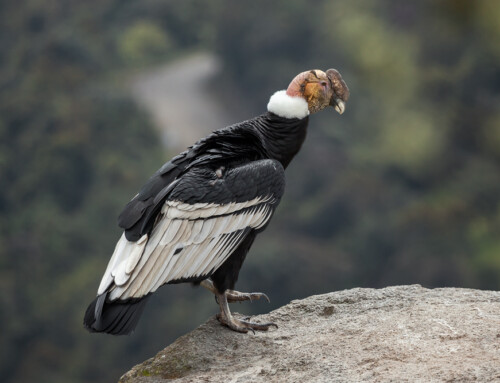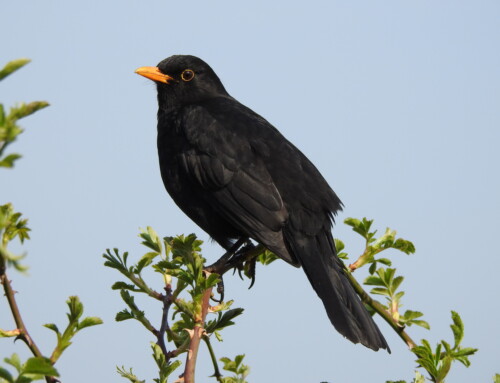LINKED PAPER
Genetic mark-recapture analysis of winter fecal pellets allows estimation of population size in Sage Grouse Centrocercus urophasianus. Shyvers, J.E., Walker, B.L., Oyler McCance, S.J., Fike, J.A. & Noon, B.R. 2019. IBIS. DOI: 10.1111/ibi.12768. VIEW
Accurate estimates of population size are valuable for conservation and management of wildlife. The Sage Grouse (or Greater Sage-Grouse), Centrocercus urophasianus, is an iconic species of sagebrush-dominated landscapes in the western United States and Canada but has declined in abundance and distribution, primarily due to the loss and degradation of sagebrush ecosystems. Recently, it has become the center of conflict over the use and management of public lands, and the focus of unprecedented range-wide research, management, and conservation efforts.
State and provincial wildlife agencies typically monitor Sage Grouse populations by counting males that strut at traditional breeding sites, known as leks (Fig. 1), in the spring to attract females for mating. Leks vary in size from 2 to nearly 200 males and the maximum counts observed each spring are used as a simple index of male abundance. These counts are widely used to monitor trends in the size and distribution of populations over time to identify critical habitat and measure population response to changes in human land-use, or conservation and management actions.
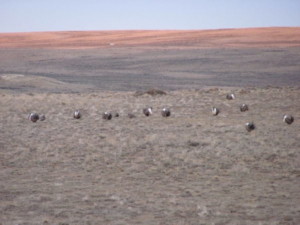
Figure 1 Male Greater Sage Grouse (with white ruffs) strut on a lek in northwestern Colorado while females assess potential mates © Brett Walker
Lek counts, however, may not be reliable indicators of population size or trend. This is because the relationship between the counts and actual Sage Grouse population size is poorly understood and typically fail to account for sources of count bias; such as imperfect male lek attendance, inter-lek movement, imperfect detectability, variation in male-to-female sex ratio, or the existence of unknown leks. Despite this, lek counts remain the only feasible method of monitoring Sage Grouse over large areas and long periods of time. This has resulted in a critical need to investigate the reliability of count data for population monitoring and has led to a growing body of research testing underlying assumptions of lek counts using new analytical techniques.
As part of a collaborative project between researchers from Colorado State University, Colorado Parks and Wildlife, and ExxonMobil/XTO Energy, and with support from the U.S. Geological Survey, we tested noninvasive genetic mark-recapture analysis as an alternative technique for estimating Sage Grouse population size. We studied a small, geographically-isolated Sage Grouse population of long-term conservation concern in western Colorado known as the Parachute-Piceance-Roan (PPR; Fig. 2). The PPR represents only 4% of Colorado’s total Sage Grouse population and is unique in that the birds inhabit sagebrush-dominated terrain on a high-elevation plateau (2,150-2,750 m; Fig 3). The population faces several environmental stressors that pose a risk to its persistence, including pinyon-juniper encroachment, and energy development. Accurate baseline estimates of population size will be required to understand long-term population responses to these stressors.
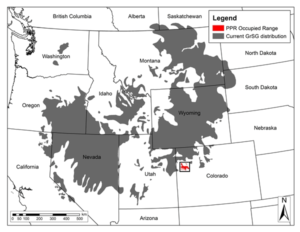
Figure 2 The current Sage Grouse range in the western U.S. and Canada with the Parachute-Piceance-Roan (PPR) population identified in red. Map adapted from Schroeder et al. (2004) with PPR occupied range from Colorado Parks and Wildlife

Figure 3 The Parachute-Piceance-Roan is a geographically isolated, naturally fragmented, high-elevation Sage Grouse population in western Colorado © Jessica Shyvers
We used non-invasive genetic mark-recapture (GMR) to estimate population size of Sage Grouse in the PPR during two consecutive winter seasons from 2012-2014. While this method has been used to estimate abundance for many wildlife species of conservation concern, such as grizzly bears, forest elephants, northern goshawks, and tigers, it had not previously been attempted in Sage Grouse. We conducted non-invasive sampling of fecal pellets in winter (Fig. 4) in a mountainous region using snowmobiles to access remote and largely uninhabited terrain and conduct surveys following meticulous sampling protocols (Fig. 5).
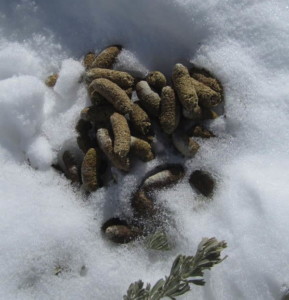
Figure 4 A recently deposited Sage Grouse roost pile in winter. Birds typically deposit piles of fecal pellets while roosting at night or during the day © Jessica Shyvers

Figure 5 Sampling Sage Grouse fecal pellets from flock-use sites in winter © Jessica Shyvers
We analyzed DNA from the pellets collected and used mark-recapture analysis to generate estimates of male and female population size. We then compared our estimates against lek-count data to evaluate their reliability for determining both population size and trend in the PPR population. Non-invasive GMR methods often suffer from high rates of DNA degradation (resulting low rates of DNA amplification success) that complicate analysis and may bias results. In our study, collecting fecal pellets in winter, when temperatures were typically at or below freezing, minimized degradation of DNA in our samples and substantially improved our analysis and results.
We processed 2,357 genetic samples for use in our analysis and found that conducting surveys in winter, in combination with careful handling and storage of fecal pellets in the field, minimized issues of DNA degradation and resulted in >85% amplification success for fecal pellets. We determined that the population of Sage Grouse in the PPR approximately doubled between our winter our two winter seasons, from 335 (95% CI: 287-382) in the first winter to 745 (95% CI: 627-864) the next. Notably, the direction and magnitude of this change mirrored that of the associated lek-count records from spring 2013 and spring 2014, which increased from 129 to 250 total males. However, these values were a poor match to our GMR estimates and either did not fall, or barely fell, within the 95% confidence intervals. The lek-count data appeared to overestimate population size in the first winter and, in contrast, underestimated it in the second. This suggests that, while lek-counts indicated a large increase in male abundance from one year to the next, male count data performed poorly for estimating actual male population size in either year.
The intensive field effort required, the difficulty of randomly sampling in winter, and the cost of genetic extraction and analysis currently make this method impractical for annual monitoring. However, non-invasive genetic sampling in winter combined with mark recapture analysis is now a valuable tool for researchers when point estimates of abundance are needed for specific Sage Grouse populations of concern.
Nominate this article for a BOU Science Communication Award.
References
Shyvers, J.E., Walker, B.L. & Noon, B.R. 2018. Dual-frame lek surveys for estimating sage-grouse populations. Journal of Wildlife Management 82: 1689-1700. VIEW
Schroeder, M.A., Aldridge, C.L., Apa, A.D., Bohne, J.R., Braun, C.E., Bunnell, S.D., Connelly, J.W., Deibert, P.A., Gardner, S.C., Hilliard, M.A., Kobriger, G.D. & McCarthy, C.W. 2004. Distribution of sage-grouse in North America. Condor 106: 363-376. VIEW
Walker, B.L., Apa, A.D. & Eichhoff, K. 2016. Mapping and prioritizing seasonal habitats for greater sage-grouse in northwestern Colorado. Journal of Wildlife Management 80: 63-77. VIEW
Western Association of Fish and Wildlife Agencies 2015. Greater sage-grouse population trends: an analysis of lek count databases 1965-2015. Western Association of Fish and Wildlife Agencies, Cheyenne, WY. VIEW
Image credit
Featured image: Adult male Sage Grouse (Centrocercus urophasianus) in winter © Brett Walker




